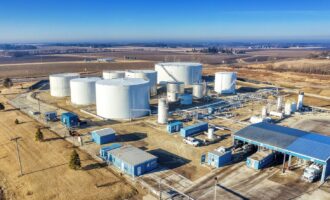The next API heavy-duty performance engine oil category is almost here
By Alison Gaines
It has been 10 years since the American Petroleum Institute (API) ushered in a new performance category for heavy-duty engine oils. This December, it will do so again with API CK-4 and FA-4. Until February, the new category was known as Proposed Category 11 (PC-11).
There are three stages before a new category becomes a reality — category request, development and implementation. The implementation phase exists so that oil marketers have time to qualify their oils, which includes nine tests that the New Category Development Team (NCDT) has spent the last few years finalising. Two of these tests are new, while seven are carried over from previous categories, in one case with tougher limits.
As the chair of NCDT, Dan Arcy, global OEM technical manager and industry trade association liaison at Shell Global Solutions, is on a mission to get the word out about the new category and what it means for all stakeholders. According to Arcy, one of the least understood aspects of this category is the fact that it’s actually split into two, which is unprecedented. CK-4 is backward compatible, as evidenced by the fact that its name follows that of the current category, API CJ-4. FA-4 will offer additional fuel economy benefits and will apply to oils with lower high temperature, high shear (HTHS) viscosity, and engines that are meant to be lubricated with them. Thus, API FA-4 oils will only have limited backward compatibility.
Most consumers don’t understand why API created two categories in the first place, he said. This is because most consumers understand viscosity in terms of SAE viscosity grades, as defined in SAE J300 (Engine Oil Viscosity Classification). SAE viscosity grades go under broad names, such as SAE 30 or 40, each spanning a range of viscosities measured in centistokes. HTHS viscosity is measured in centipoise (cP) or millipascals times seconds.
 Because of these different ways of measuring viscosity, customers who usually buy SAE 30 oils will have a choice between API CK-4 and FA-4, since both are available as SAE 30. Arcy offers this helpful analogy: a freshman and a senior are both high school students, but they are very different in terms of maturity.
Because of these different ways of measuring viscosity, customers who usually buy SAE 30 oils will have a choice between API CK-4 and FA-4, since both are available as SAE 30. Arcy offers this helpful analogy: a freshman and a senior are both high school students, but they are very different in terms of maturity.
Aside from oil marketers qualifying their oils, there are a few tasks left before API CK-4 and FA-4 reach their first license date of December 1, 2016. API is working on options to package and market oils under the new category, which poses a new challenge due to the two categories. The API “donut” is the circular symbol that displays the performance category and SAE viscosity grade on bottles of API-licensed oils. Typically, the top part of the donut displays the performance standard. Arcy said that the API is considering ways to make the performance category stand out more, so that customers will notice the difference between the two categories. So far, a decision hasn’t been reached on what the donut will look like, but using colour might be an option, he said.
API has contracted a public relations firm to survey drivers and fleet owners to gauge the public’s knowledge of performance categories, and to understand what people look for when selecting oils. So far, they’ve found that most people look for two things: the brand name and the SAE viscosity grade. Arcy said the goal is to get people to take one more step and include performance category in their considerations.
“You need to take that extra step to define the performance level that you want,” Arcy said.
On the OEM front, he said that if history repeats itself, OEMs will begin to design their own specifications based on the new API categories. For example, Volvo, Cummins and Detroit Diesel have come out with their own specs in the past. Often, OEMs’ in-house specifications will include tougher limits on one or some of the tests, or additional tests outside of the CK-4 and FA-4 matrix. While no official specifications have been released yet, Arcy said that many OEMs plan to introduce their specifications this summer, for both the high and low HTHS oils.

While both API and ACEA standards are used around the world, Asian countries tend to adopt API specifications. “Everyone wants the same thing,” he said, “fuel economy and reduced greenhouse gas emissions.” Adopting these new performance categories is one way for some Asian cities to bring down pollution, when used in conjunction with advanced engine technologies and high-quality fuels. While Asia-Pacific may not adopt the new performance standards exactly when North America does, “the Asian market tends to adopt these standards at a much faster rate. It may lag behind North America for a few years, but the change is happening pretty rapidly,” he said. For example, Singapore has announced that it will implement Euro VI emission standards for diesel vehicles by Jan. 1, 2018.
The past year’s plunge in oil prices has meant that for some fleets, fuel is no longer the number one expense. However, everyone still wants to gain fuel efficiency. Arcy hesitated to make predictions on the uptake of the new category after his presentation at F+L Week conference organised by F&L Asia recently in Singapore, but “fleets are pretty smart,” he said. “Some of the fleets will probably be the first adopters.”
The current category, API CJ-4, was around for 10 years. Arcy can’t predict how long API CK-4 and FA-4 will be around, but changes in emissions regulations or some tests in the category becoming obsolete would be some of the reasons for change. A couple of the tests in the category, including the Caterpillar 1N test for piston deposits, as well as the Cummins ISM and ISB tests for valvetrain wear, will eventually run out of parts. The engines used in the ISM and ISB tests are no longer being produced. It’s all “crystal ball predictions” at this point, according to Arcy, but it’s possible that some of these tests will need to be replaced around the same time that the U.S. Environmental Protection Agency (EPA) introduces a new emissions regulation in less than 10 years.







